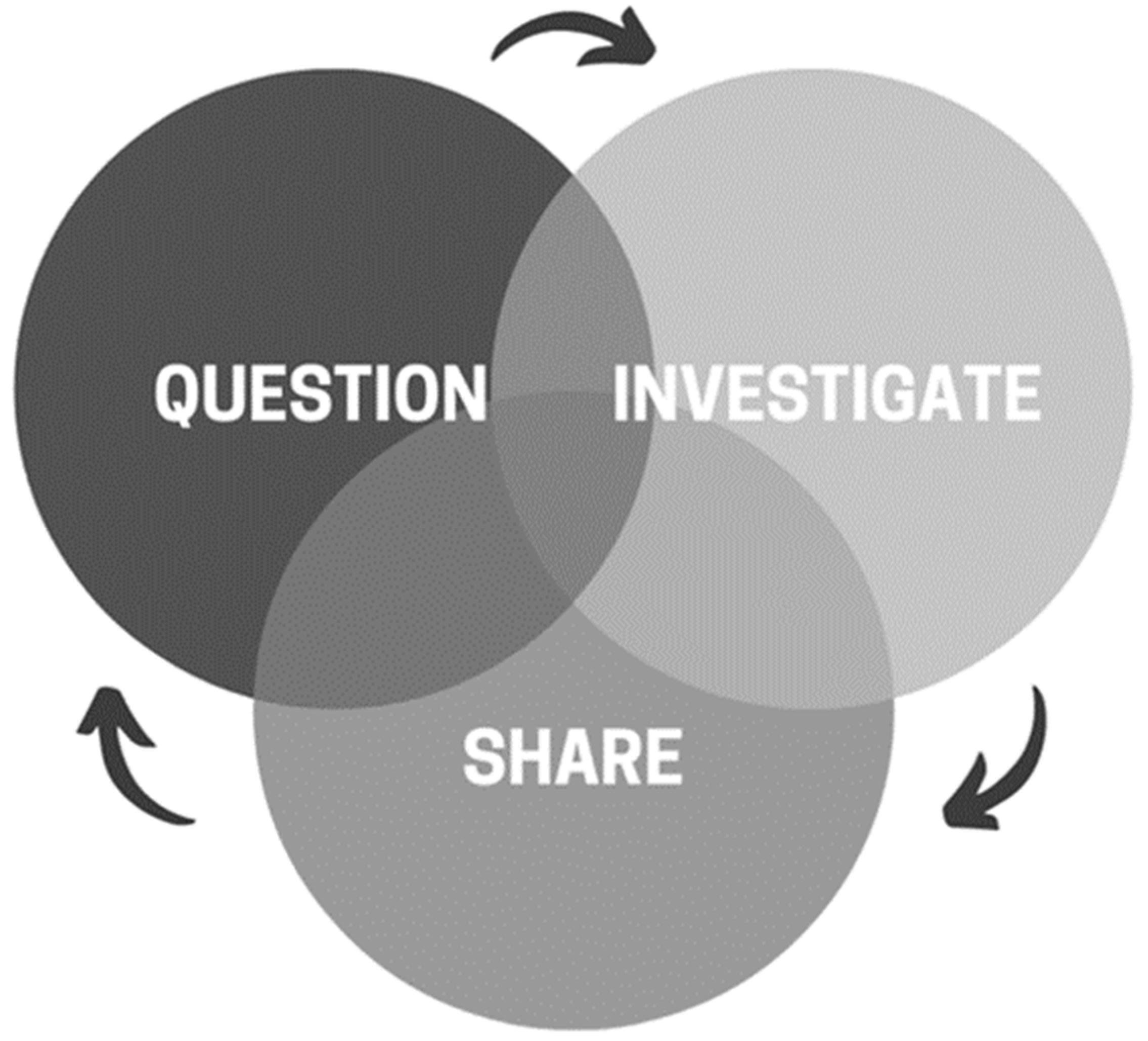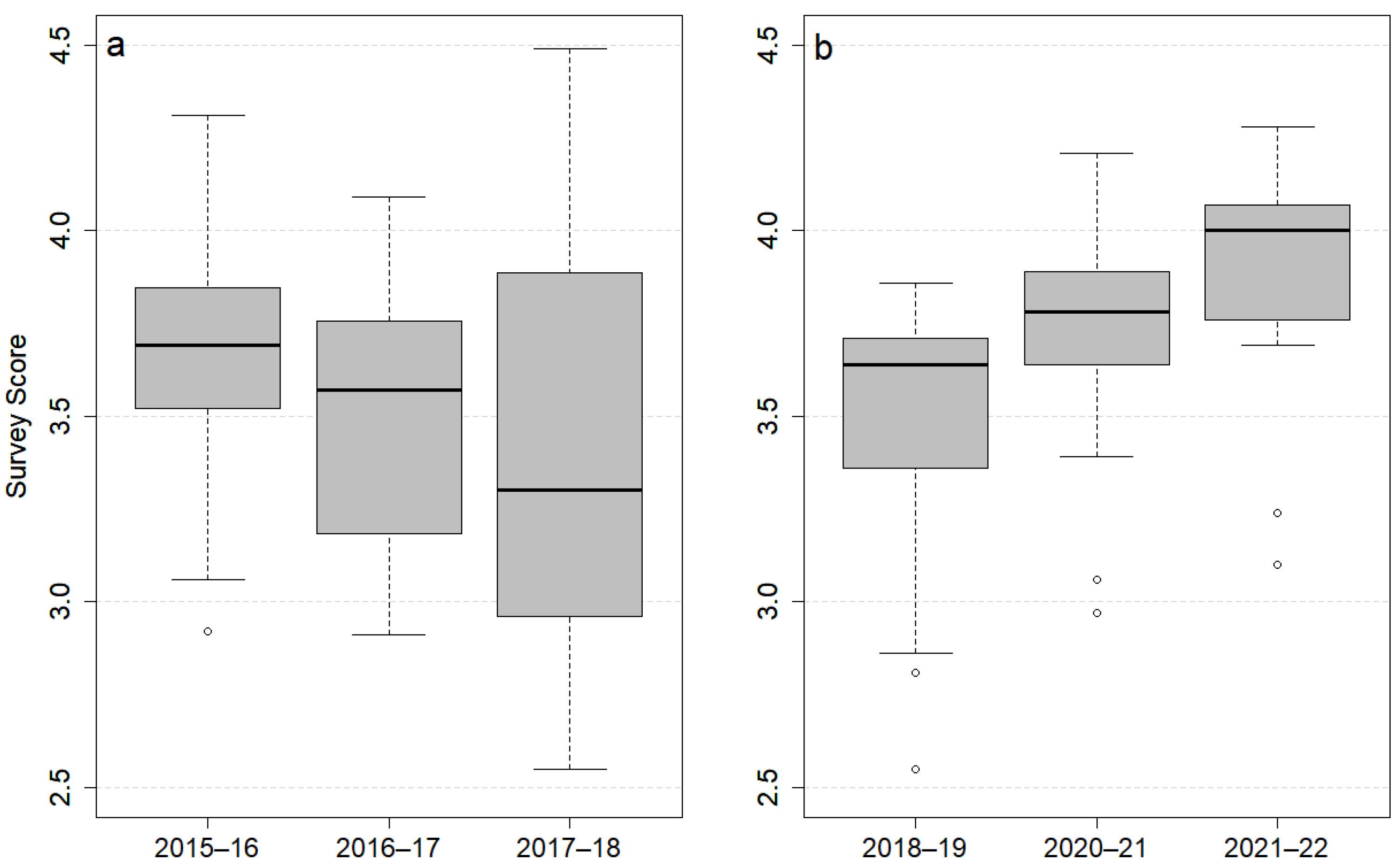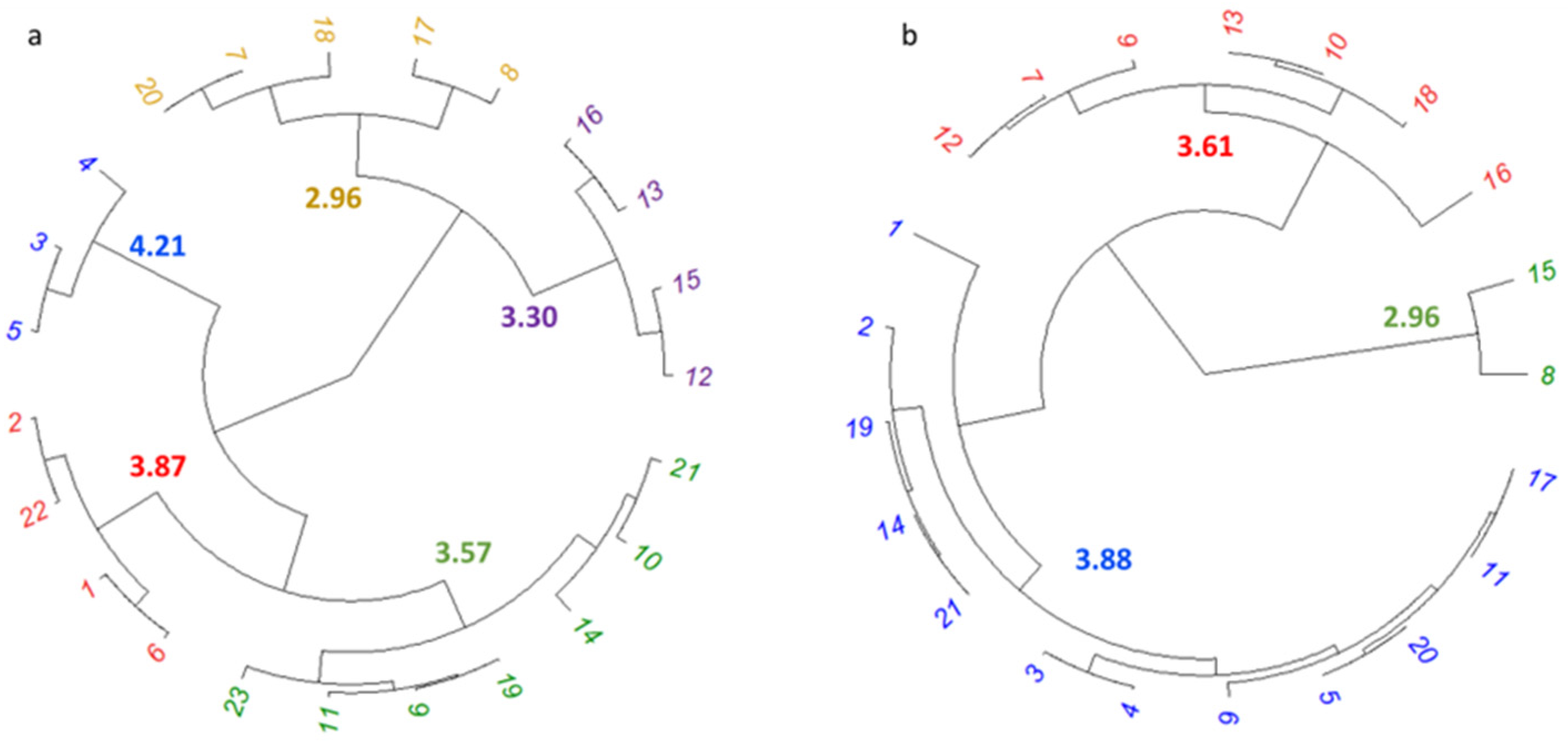Effects of COVID-19 on First-Year Undergraduate Research in Physical Geography
Abstract
:1. Introduction
2. Materials and Methods
3. Results
3.1. Survey Responses
3.2. Cluster Analysis
3.3. Pre-COVID-19 vs. COVID-19 Responses
4. Discussion
4.1. Effects of FYRE in the Three Years before COVID-19 (2015–18)
4.2. Effects of FYRE on Difference Aspects with Different Survey Questions
4.3. Effects of COVID-19 on the FYRE
4.4. Changes during COVID-19
5. Conclusions
Author Contributions
Funding
Institutional Review Board Statement
Informed Consent Statement
Data Availability Statement
Acknowledgments
Conflicts of Interest
References
- Guo, X.; Loy, K.; Banow, R. Can first-year undergraduate students do individual research? J. Geogr. High. Educ. 2018, 42, 412–426. [Google Scholar] [CrossRef]
- Day, T.; Chang, I.-C.C.; Chung, C.K.L.; Doolittle, W.E.; Housel, J.; McDaniel, P.N. The immediate impact of COVID-19 on postsecondary teaching and learning. Prof. Geogr. 2021, 73, 1–13. [Google Scholar] [CrossRef]
- Li, Y.; Krause, S.; McLendon, A.; Jo, I. Teaching a geography field methods course amid the COVID-19 pandemic: Reflections and lessons learned. J. Geogr. High. Educ. 2023, 47, 339–348. [Google Scholar] [CrossRef]
- Zhu, X.; Gong, Q.; Wang, Q.; He, Y.; Sun, Z.; Liu, F. Analysis of students’ online engagement during the COVID-19 pandemic: A case study of a SPOC-based geography education undergraduate course. Sustainability 2023, 15, 4544. [Google Scholar] [CrossRef]
- Wypyczynski Martins, R.E.M.; Santos Mauricio, S.; Araújo Michielin, C. Supervised curricular internship in geography: Challenges of teacher learning in times of pandemic. Ensino Em Re-Vista 2022, 29, e032. [Google Scholar] [CrossRef]
- West, H.; Hill, J.; Abzhaparova, A.; Cox, W.; Alexander, A. Pandemic pedagogies: Reflecting on online learning using the community of inquiry framework. J. Geogr. High. Educ. 2023. [Google Scholar] [CrossRef]
- Seymour, E.; Hunter, A.-B.; Laursen, S.L.; Deantoni, T. Establishing the benefits of research experiences for undergraduates in the science: First findings from a three-year study. Sci. Educ. 2004, 88, 493–534. [Google Scholar] [CrossRef]
- Linn, M.C.; Palmer, E.; Baranger, A.; Gerard, E.; Stone, E. Undergraduate research experiences: Impacts and opportunities. Science 2015, 347, 1261757. [Google Scholar] [CrossRef]
- Willison, J.; O’Reagan, K. Commonly known, commonly not known, totally unknown: A framework for students becoming researchers. High. Educ. Res. Dev. 2007, 26, 393–409. [Google Scholar] [CrossRef]
- Shaffer, C.D.; Alvarez, C.J.; Bednarski, A.E.; Dunbar, D.; Goodman, A.L.; Rosenwald, A.G.; Wolyniak, M.J.; Bailey, C.; Barnard, D.; Bazinet, C.; et al. A course-based research experience: How benefits change with increased investment in instructional time. CBE Life Sci. Educ. 2014, 13, 111–130. [Google Scholar] [CrossRef] [PubMed]
- Barnett, R. Introduction. In Reshaping the University: New Relationships between Research, Scholarship and Teaching; Barnett, R., Ed.; The Society for Research into Higher Education and the Open University Press: London, UK, 2005; pp. 1–8. [Google Scholar]
- Bangera, G.; Brownell, S.E. Course-based undergraduate research experiences can make scientific research more inclusive. CBE Life Sci. Educ. 2014, 13, 602–606. [Google Scholar] [CrossRef]
- Eagan, M.K., Jr.; Hurtado, S.; Chang, M.J.; Garcia, G.A.; Herrera, F.A.; Garibay, J.C. Making a difference in science education: The impact of undergraduate research programs. Am. Educ. Res. J. 2013, 50, 683–713. [Google Scholar] [CrossRef] [PubMed]
- Maton, K.I.; Hrabowski, F.A., III; Schmitt, C.L. African American college students excelling in the sciences: College and postcollege outcomes in the Meyerhoff Scholars Program. J. Res. Sci. Teach. 2000, 37, 629–654. [Google Scholar] [CrossRef]
- Kedraka, K.; Kaltsidis, C. Effects of the COVID-19 pandemic on university pedagogy: Students’ experiences and considerations. Eur. J. Educ. Stud. 2020, 7, 17–30. [Google Scholar] [CrossRef]
- El Refae, G.A.; Kaba, A.; Eletter, S. The impact of demographic characteristics on academic performance: Face-to-face learning versus distance learning implemented to prevent the spread of COVID-19. Int. Rev. Res. Open Dist. 2021, 22, 91–110. [Google Scholar] [CrossRef]
- Woo, K.; Gosper, M.; McNeill, M.; Preston, G.; Green, D.; Phillips, R. Web-based lecture technologies: Blurring the boundaries between face-to-face and distance learning. Res. Learn. Technol. 2008, 16, 81–93. [Google Scholar] [CrossRef]
- Pelletier, K.; McCormack, M.; Reeves, J.; Robert, J.; Arbino, N.; Al-Freih, M.; Dickson-Deane, C.; Guevara, C.; Koster, L.; Sánchez-Mendiola, M.; et al. 2022 EDUCAUSE Horizon Report Teaching and Learning Edition; EDUCAUSE: Boulder, CO, USA, 2022; pp. 1–58. [Google Scholar]
- Sadika, B.; Soubry, I.; Kleiboer, B.; Aubrey-Wake, C.; Toop, F.; Leonhardt, R.; Lindsay, R.; Massie, M. The First Year Research Experience (FYRE): Through the eyes of research coaches. Persp. Undergr. Res. Ment. 2021, 10, 1. [Google Scholar]
- Houseman, L. FYRE (First Year Research Experience) 2019–2022 Summary Report; University of Saskatchewan: Saskatoon, SK, Canada, 2022; 16p, Unpublished report. [Google Scholar]
- Paradis, E.; Schliep, K. ape 5.0: An environment for modern phylogenetics and evolutionary analyses in R. Bioinformatics 2019, 35, 526–528. [Google Scholar] [CrossRef] [PubMed]
- R Core Team. R: A Language and Environment for Statistical Computing; R Foundation for Statistical Comuting: Vienna, Austria, 2021; Available online: https://www.R-project.org/ (accessed on 6 June 2022).
- Werth, A.; West, C.G.; Lewandowski, H.J. Impacts on student learning, confidence, and affect in a remote, large-enrollment, course-based undergraduate research experience in physics. Phys. Rev. Phys. Edu. Res. 2022, 18, 010129. [Google Scholar] [CrossRef]
- Marek, M.W.; Chew, C.S.; Wu, W.-C.V. Teacher experience in converting classes to distance learning the COVID-19 pandemic. Int. J. Distance Educ. Technol. 2021, 19, 89–109. [Google Scholar] [CrossRef]





| # | Question |
|---|---|
| 1 | I thought the research experience was adequately organized. |
| 2 | I understood the purpose of the research experience when it was introduced. |
| 3 | I think I have an understanding of research: what it is and how it works. |
| 4 | To my knowledge, we investigated using resources relevant to geography. |
| 5 | In the research we conducted, I contributed to creating a research question. |
| 6 | We shared or disseminated our results with someone other than our instructor. |
| 7 | Because of the research experience, I have a better idea about what courses I would like to take (or not to take) in the future. |
| 8 | Because of the research experience, I have a better idea about what subject I want to major in (or what subject I know I do not want to major in). |
| 9 | I think I have an increased understanding of geography because of the research experience. |
| 10 | I think I have an increased understanding of how research works because of the research experience. |
| 11 | I believe my research skills have improved as a result of the research experience. |
| 12 | I believe my professional skills (i.e., critical thinking, problem-solving, and getting along in groups) have improved as a result of the research experience. |
| 13 | I believe my academic skills (i.e., finding and reading journal articles, summarizing research findings) have improved as a result of the research experience. |
| 14 | I found the research experience to be engaging (interesting and captivating). |
| 15 | The research experience made me more engaged (interested) in class. |
| 16 | The research experience made me more engaged in learning about geography. |
| 17 | I have a better idea about what I would like to pursue (or not pursue) as a career because of the research experience. |
| 18 | Because of the research experience, I have a better idea about my interest (or lack thereof) in graduate studies (i.e., pursuing a master’s degree or PhD). |
| 19 | I think I have a better idea about how researchers think and work as a result of the research experience. |
| 20 | I feel like I think and work more like a researcher since the research experience. |
| 21 | I believe participating in the research experience will contribute to my academic success. |
| 22 | I think I have an understanding of the purpose of research on campus. |
| 23 | I have discussed the good things about my research experience with other people on or off campus. |
| # | Question |
|---|---|
| 1 | I have a clearer understanding of how a research question is constructed because of the FYRE project. |
| 2 | I am better equipped to identify and find good research/scholarly sources because of the FYRE project. |
| 3 | I am better equipped to summarize findings from multiple sources to construct a scholarly review because of the FYRE project. |
| 4 | I am better equipped to analyze data because of the FYRE project. |
| 5 | I am better equipped to interpret results and present evidence because of the FYRE project. |
| 6 | I better understand the importance of being a critical consumer of information because of the FYRE project. |
| 7 | I have an increased tolerance for obstacles and setbacks (resilience) because of the FYRE project. |
| 8 | I had opportunity to give constructive feedback to others during the FYRE project. |
| 9 | I asked for and received guidance and feedback (i.e., from my peers, research coach, or professor) during the FYRE project. |
| 10 | I practiced and further developed self-management and time management skills because of the FYRE project. |
| 11 | I practiced and further developed project management skills (i.e., task breakdown, critical thinking, decision-making, quality management, risk, and reward decisions) because of the FYRE project. |
| 12 | Sharing FYRE project findings with people beyond the professor helped me think and speak more clearly about my research. |
| 13 | I practiced and further developed writing skills to analyze, understand and explain the FYRE project findings. |
| 14 | I practiced and further developed presentation skills (oral, poster, or online) during the FYRE project. |
| 15 | I felt more connected to others (such as other students, the research coach, or the professor) in this class because of the FYRE project. |
| 16 | I was self-motivated and interested in working on the FYRE project. |
| 17 | Because of the FYRE project, I will go into my next course or research project with more confidence. |
| 18 | The FYRE project made me more engaged in learning about geography. |
| 19 | I have an increased understanding of a university’s role in generating and assessing knowledge because of the FYRE project. |
| 20 | I am proud of the work I contributed to this FYRE project. |
| 21 | The amount of time devoted to the FYRE project was of value to my overall education goals and skill development. |
| Survey Version | Academic Year | Total Enrollment | Survey Response | Response Rate (%) |
|---|---|---|---|---|
| 2015–18 | 2015–16 | 124 | 77 | 62.1 |
| 2016–17 | 121 | 70 | 57.9 | |
| 2017–18 | 122 | 67 | 54.9 | |
| Average | 122 | 71 | 58.3 | |
| 2018–22 | 2018–19 | 111 | 22 | 19.8 |
| 2020–21 | 114 | 38 | 33.3 | |
| 2021–22 | 120 | 29 | 24.2 | |
| Average | 115 | 30 | 25.8 |
| Cluster | Survey Questions | Standard Deviation | Median | Range | |
|---|---|---|---|---|---|
| Old surveys | |||||
| 1 | 3 (3, 4, 5) | 4.21 | 0.08 | 4.18 | 0.15 |
| 2 | 4 (1, 2, 6, 22) | 3.87 | 0.06 | 3.87 | 0.12 |
| 3 | 7 (6, 10, 11, 14, 19, 21, 23) | 3.57 | 0.07 | 3.54 | 0.21 |
| 4 | 4 (12, 13, 15, 16) | 3.30 | 0.07 | 3.30 | 0.15 |
| 5 | 5 (7, 8, 17, 18, 20) | 2.96 | 0.13 | 2.97 | 0.29 |
| New surveys | |||||
| 1 | 12 (1, 2, 3, 4, 5, 6, 11, 14, 17, 19, 20, 21) | 3.88 | 0.07 | 3.88 | 0.26 |
| 2 | 7 (7, 9, 10, 12, 13, 16, 18) | 3.61 | 0.08 | 3.60 | 0.22 |
| 3 | 2 (8, 15) | 2.96 | 0.12 | 2.96 | 0.17 |
| 2019–2020 vs. 2020–2022 surveys | |||||
| 1 | 3 (10, 16, 20) | 0.80 | 0.11 | 0.76 | 0.21 |
| 2 | 2 (8, 18) | 0.53 | 0.06 | 0.53 | 0.08 |
| 3 | 10 (1, 2, 3, 4, 5, 12, 13, 15, 17, 21) | 0.32 | 0.07 | 0.34 | 0.20 |
| 4 | 6 (6, 7, 9, 11, 14, 19) | 0.06 | 0.10 | 0.05 | 0.28 |
| 2020–2021 vs. 2021–2022 surveys | |||||
| 1 | 2 (18, 21) | 0.46 | 0.04 | 0.46 | 0.05 |
| 2 | 13 (2, 3, 4, 6, 7, 8, 9, 10, 11, 13, 15, 16, 20) | 0.21 | 0.07 | 0.21 | 0.20 |
| 3 | 6 (1, 5, 12, 14, 17, 19) | -0.05 | 0.05 | -0.06 | 0.13 |
Disclaimer/Publisher’s Note: The statements, opinions and data contained in all publications are solely those of the individual author(s) and contributor(s) and not of MDPI and/or the editor(s). MDPI and/or the editor(s) disclaim responsibility for any injury to people or property resulting from any ideas, methods, instructions or products referred to in the content. |
© 2023 by the authors. Licensee MDPI, Basel, Switzerland. This article is an open access article distributed under the terms and conditions of the Creative Commons Attribution (CC BY) license (https://creativecommons.org/licenses/by/4.0/).
Share and Cite
Chutko, K.J.; Guo, X. Effects of COVID-19 on First-Year Undergraduate Research in Physical Geography. Educ. Sci. 2023, 13, 1081. https://doi.org/10.3390/educsci13111081
Chutko KJ, Guo X. Effects of COVID-19 on First-Year Undergraduate Research in Physical Geography. Education Sciences. 2023; 13(11):1081. https://doi.org/10.3390/educsci13111081
Chicago/Turabian StyleChutko, Krystopher J., and Xulin Guo. 2023. "Effects of COVID-19 on First-Year Undergraduate Research in Physical Geography" Education Sciences 13, no. 11: 1081. https://doi.org/10.3390/educsci13111081
APA StyleChutko, K. J., & Guo, X. (2023). Effects of COVID-19 on First-Year Undergraduate Research in Physical Geography. Education Sciences, 13(11), 1081. https://doi.org/10.3390/educsci13111081





